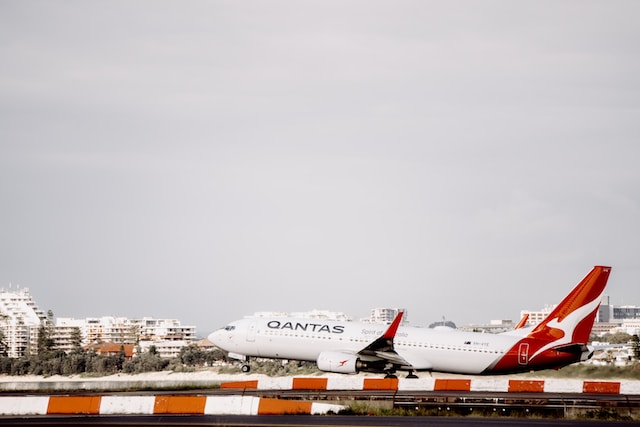Before we dive deep into the SWOT analysis, let’s get the business overview of Qantas. Qantas Airways Limited, founded in 1920, is the flag carrier airline of Australia and one of the oldest airlines in the world. With its primary hub located in Sydney, Qantas is headquartered in Mascot, New South Wales.
The airline is a founding member of the Oneworld airline alliance and operates a comprehensive domestic and international network, serving numerous destinations across six continents.
Qantas Group comprises several subsidiary airlines and businesses:
- QantasLink: Qantas’ regional subsidiary, providing services to regional and remote areas within Australia.
- Jetstar Airways: A wholly-owned low-cost subsidiary serving domestic and international destinations.
- Qantas Freight: The air cargo division responsible for freight services and handling.
- Qantas Loyalty: The Group’s customer loyalty program, known as Qantas Frequent Flyer, offers rewards and benefits for members.
Qantas is known for its strong emphasis on safety, operational efficiency, and customer service. In recent years, the airline has focused on investing in newer, more fuel-efficient aircraft, reducing its environmental footprint, and expanding its network through partnerships and alliances.
- Qantas generated a revenue of $9.1 billion in FY22, a 30% decline from FY20.
- For the full 2022 financial year, the Group experienced an Underlying Loss Before Tax of $(1.86) billion and a Statutory Loss Before Tax of $(1.19) billion.
- Net debt has fallen from a high of more than $6.4 billion to $3.9 billion at the end of FY22.
Here is the SWOT analysis for Qantas
A SWOT analysis is a strategic planning tool used to evaluate the Strengths, Weaknesses, Opportunities, and Threats of a business, project, or individual. It involves identifying the internal and external factors that can affect a venture’s success or failure and analyzing them to develop a strategic plan. In this article, we do a SWOT Analysis of Qantas.
SWOT Analysis: Meaning, Importance, and Examples
Strengths
- Brand Reputation: Qantas is recognized as one of the oldest and most reputable airlines globally, with a strong brand image associated with safety, reliability, and quality service. This reputation helps Qantas attract and retain customers.
- Extensive Network: Qantas, along with its subsidiaries, operates an extensive domestic and international network, connecting numerous destinations across six continents. This broad network allows the airline to serve a wide range of passengers and destinations, enabling it to compete effectively in the global market.
- Focus on Safety: Qantas has a long-standing commitment to safety and is consistently ranked among the world’s safest airlines. This focus on safety is a significant competitive advantage, attracting customers who prioritize secure and reliable travel.
- Diverse Business Portfolio: Qantas Group comprises various businesses, including regional and low-cost carriers, air cargo, and a loyalty program. This diversification helps the company mitigate risks and capitalize on opportunities in different market segments.
- Strategic Alliances: As a founding member of the Oneworld alliance, Qantas benefits from partnerships with other leading airlines, expanding its global network and offering customers a more seamless travel experience. These alliances also lead to cost-saving opportunities through shared resources and joint ventures.
- Fleet Modernization: Qantas has invested in newer, fuel-efficient aircraft, reducing its environmental footprint and operational costs. This investment in modern technology helps the airline stay competitive and meet the growing demand for sustainable travel.
- Strong Customer Loyalty: The Qantas Frequent Flyer program boasts millions of members, fostering customer loyalty and encouraging repeat business. The program offers various rewards and benefits, making it an attractive proposition for frequent travelers.
Weaknesses
- High Operating Costs: Qantas, like other full-service carriers, faces high operating costs due to labor expenses, fuel costs, and aircraft maintenance. These costs can impact profitability, especially during economic uncertainty or increasing competition.
- Limited Low-Cost Presence: While Qantas operates Jetstar Airways as its low-cost subsidiary, the airline’s low-cost presence is not as extensive as some of its competitors. This limitation could hinder Qantas’ ability to compete effectively in the increasingly popular budget travel market segment.
- Geographic Isolation: Being based in Australia, Qantas faces the challenge of geographic isolation. Long-haul flights require more fuel and resources, leading to higher operational costs and potential environmental concerns.
- Dependence on the Australian Market: A significant portion of Qantas’ revenue is generated from the Australian domestic market. This reliance on a single market makes the airline vulnerable to fluctuations in the Australian economy or changes in travel trends.
- Labor Relations: Qantas has experienced labor disputes and strikes, which have disrupted its operations and negatively impacted its brand image. Maintaining positive labor relations is crucial for the airline to ensure smooth operations and avoid potential conflicts.
- External Factors: The airline industry is sensitive to various external factors, such as economic downturns, geopolitical tensions, and global pandemics. Qantas, like other airlines, is vulnerable to these factors, which can lead to reduced demand for air travel and impact its financial performance.
Opportunities
- Expansion of Low-Cost Services: Qantas can further expand its low-cost subsidiary, Jetstar Airways, to capture a larger share of the growing budget travel market. This expansion could help Qantas diversify its revenue streams and attract price-sensitive customers.
- Strategic Partnerships and Alliances: Qantas can continue to seek strategic partnerships and alliances with other airlines to extend its global reach, access new markets, and improve its service offerings. Collaborations can also lead to cost savings and operational efficiencies through shared resources and joint ventures.
- Digital Transformation: Qantas can invest in digital technology to enhance its customer experience, streamline operations, and improve overall efficiency. This investment could include mobile applications, online booking systems, and in-flight entertainment.
- Focus on Sustainable Practices: With the growing awareness of environmental concerns, Qantas can further invest in sustainable practices such as fuel-efficient aircraft, carbon offset programs, and waste reduction initiatives. This focus on sustainability can help the airline meet customer expectations and regulatory requirements while reducing its environmental impact.
- Targeting New Market Segments: Qantas can explore opportunities in emerging market segments, such as the premium economy and ultra-long-haul flights. Catering to these niche markets can help the airline diversify its offerings and attract new customers.
- Expansion into New Geographical Markets: Qantas can explore new geographical markets to reduce its dependence on the Australian market and capitalize on the growing demand for air travel in regions such as Asia, Africa, and South America.
- Enhancing Ancillary Revenue: Qantas can explore ways to generate additional revenue from ancillary services such as baggage fees, in-flight sales, and partnerships with hotels and car rental companies. This diversification can help the airline improve its overall profitability.
Threats
- Intense Competition: The airline industry is highly competitive, with Qantas facing competition from both full-service carriers and low-cost airlines. This competition can result in downward pressure on fares, reduced market share, and potentially lower profitability.
- Economic Downturns: Economic downturns or recessions can lead to reduced consumer spending on travel and a decline in demand for air travel services. With its significant reliance on the Australian market, Qantas could be particularly vulnerable to economic fluctuations in the region.
- Fluctuating Fuel Prices: Fuel costs represent a significant portion of an airline’s operating expenses. Volatile fuel prices can impact Qantas’ profitability, and the airline may not always be able to pass on increased costs to customers through higher fares.
- Regulatory Changes and Environmental Policies: Qantas is subject to various national and international regulations impacting its operations, such as safety standards, emissions targets, and noise restrictions. Changes in these regulations or introducing new environmental policies could increase operating costs or require substantial investments in new technology.
- Labor Disputes: As mentioned previously, Qantas has faced labor disputes in the past. Potential future labor issues could disrupt operations, damage the company’s reputation, and lead to higher operating costs.
- Health Crises or Global Pandemics: The COVID-19 pandemic demonstrated the vulnerability of the airline industry to health crises. Any future pandemics or health crises could significantly impact demand for air travel, leading to reduced revenues and operational challenges for Qantas.
- Geopolitical Tensions and Terrorism: Geopolitical tensions and terrorist attacks can impact the airline industry by reducing demand for air travel or increasing security and operational costs. With its extensive international network, Qantas could be affected by these global threats.
- Currency Fluctuations: As an international business, Qantas is exposed to currency fluctuations that can impact its revenues and profitability. The airline must manage this risk to minimize potential adverse effects on its financial performance.









